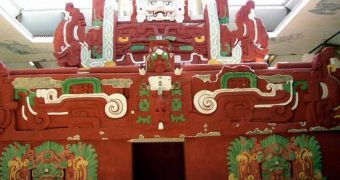Among the three great civilizations in America before its discovery by Columbus (Aztec, Inca and Maya), the Mayans from Central America were by far the most advanced, culturally and artistically.
The Mayans were the sole people of the pre-Hispanic America who created a complex hieroglyphic writing, a counting system, and a calendar forecasting the minimal fixings, their astronomical knowledge overpassing that of the contemporaneous Europeans.
The Mayans were also famous for their pyramidal temples, up to 60 m (200 ft) tall. A new research published in the "Journal of Raman Spectroscopy" shows that the Mayans painted some of their temples with mica in order to make them shine in the sunlight. Mica traces have been found in paint samples coming from the Rosalila temple in Cop?n, Honduras. The temple was constructed in the 6th century A.D., and it was later "swallowed" by a giant pyramid built around it.
"The covering of sparkling paint likely gave the sacred site a dazzling appearance. The mica pigment would have had a lustrous effect. Mica is used today in paints for that very purpose-to create a shimmering finish to the paint," lead author, Rosemary Goodall, a doctoral student in physical sciences at Australia's Queensland University of Technology, told National Geographic News.
"The gleaming paint also appears to have been applied periodically, perhaps in honor of important anniversaries or ceremonial events," she added.
The researchers investigated the red, green, and gray dyes painted over the stucco masks on the outer walls of the temple, using a new infrared analysis technique.
"The mica used in the paint likely came from beyond the Maya realm. It appears that mica was available in what is now Guatemala. [The Maya] would have had to trade for something like that. (This) gives us an insight into how people in the southern periphery [of the Maya realm] interacted with people in the more northern regions," said Goodall. The team believes that the mica was applied based on a religious schedule.
"Mica has only been found on the Rosalila temple so far. The building was in use for one hundred years-we know that because [the Maya] dated the opening ceremony of the building, and they dated the closing ceremony. It was repainted somewhere between 15 and 20 times, but mica was only used, I estimate, in every fourth or fifth repainting. It's not on every layer. More than likely there was something very significant about when they used it, if it was only used infrequently," said Goodall.
"The Maya had very regular calendar periods, so the next step is to look at the core [of the paint layers] and see if we can find out the frequency of [mica's] use, which may give us an indication of whether or not it was applied to celebrate one of these period endings, or to mark some significant date," she added.
"I think that's a very interesting idea, because the Maya numerical system is a base-20 system, so their calendar is based on a 20-year period called a katun. We know from hieroglyphs that these katun endings, or these 20-year periods, were important times of ceremony in the life of the king. Obviously Rosalila would have been a very important place for Cop?n's royalty," Cynthia Robin, an anthropologist and Maya expert at Northwestern University in Illinois, told National Geographic News.

 14 DAY TRIAL //
14 DAY TRIAL //